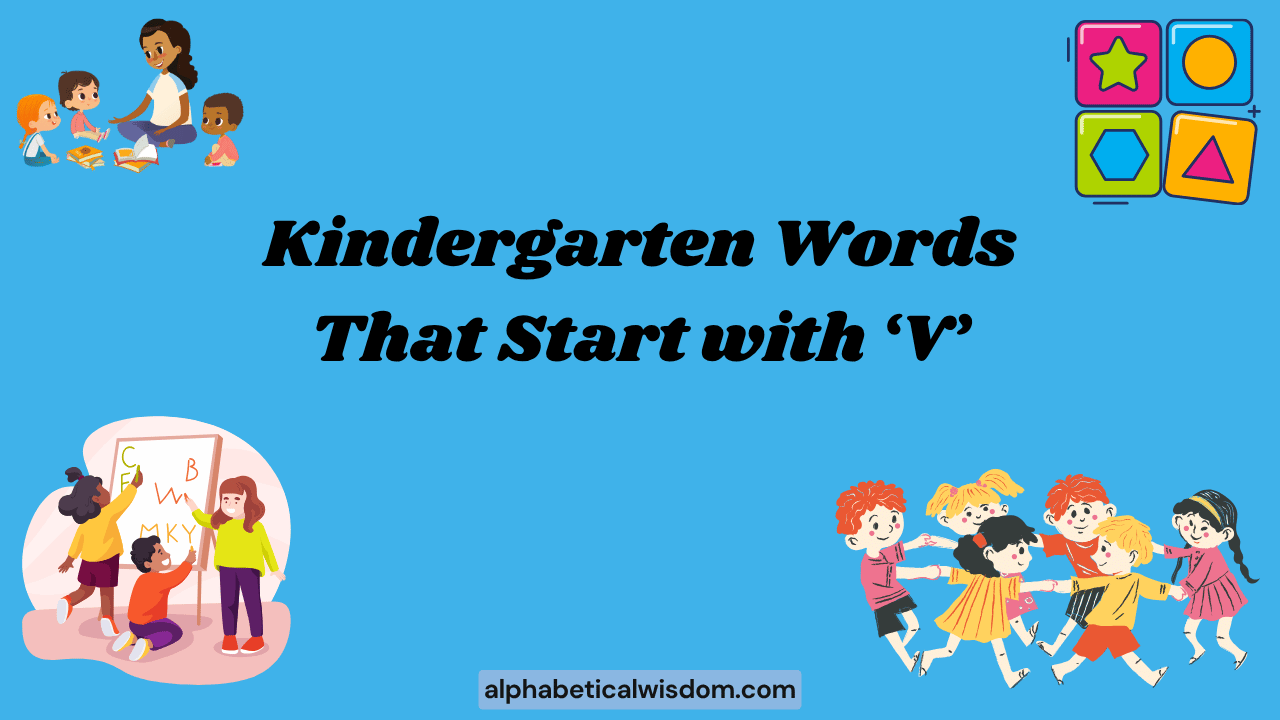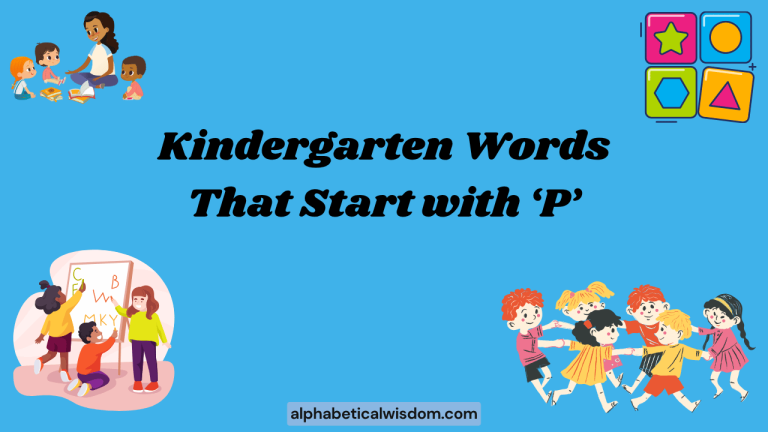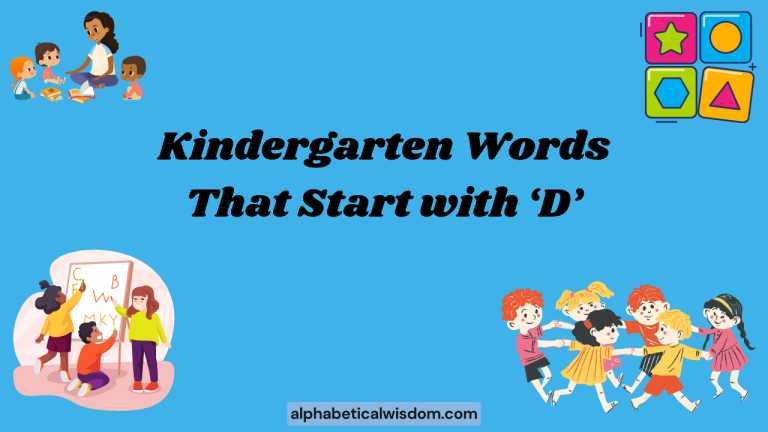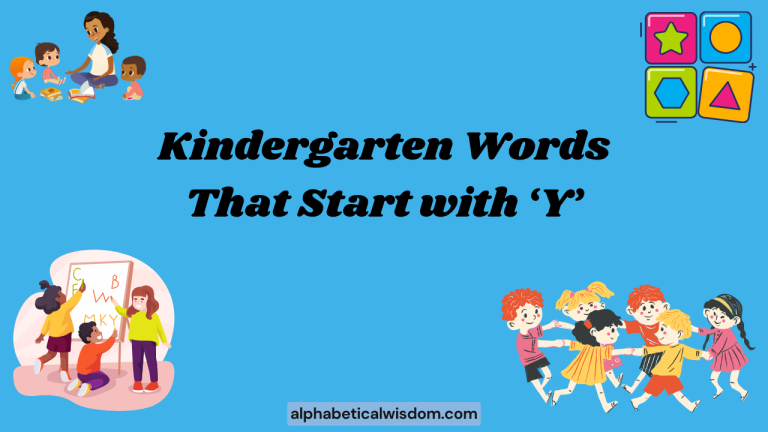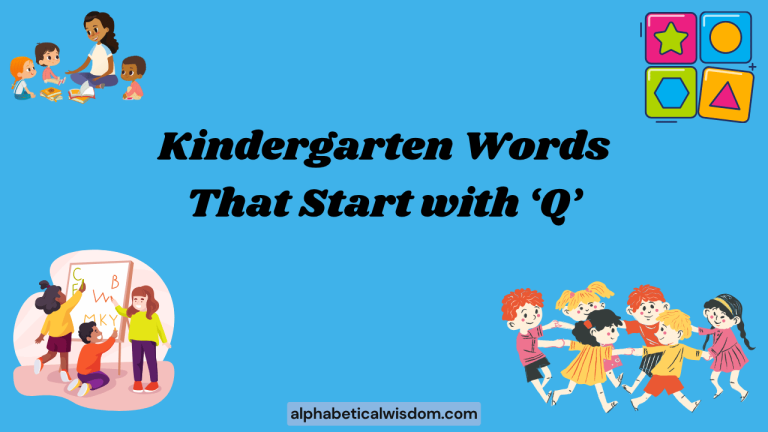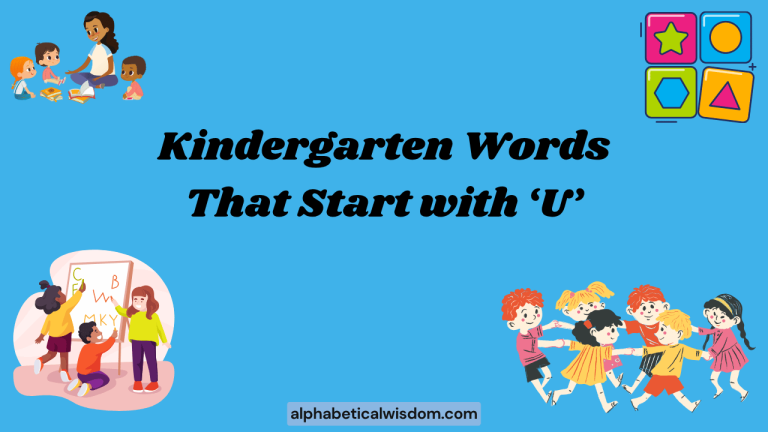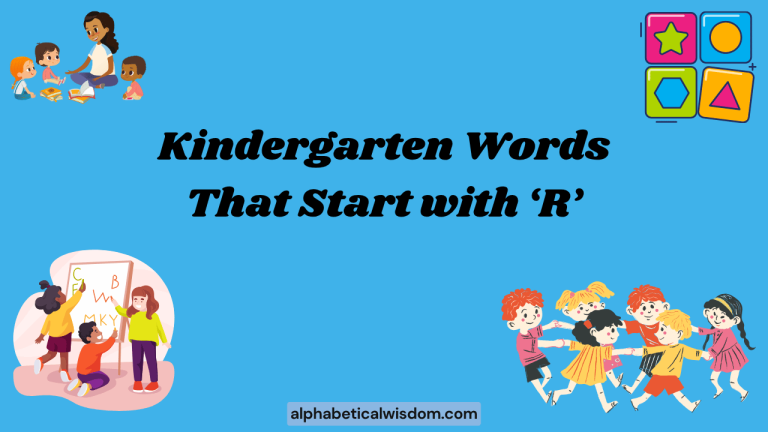Kindergarten Words Starting with V: A Comprehensive Guide
Introducing kindergarteners to words that start with the letter ‘V’ is a crucial step in their literacy journey. Mastering these words helps expand their vocabulary, improves reading comprehension, and builds a strong foundation for future language skills.
This guide provides a detailed exploration of ‘V’ words suitable for kindergarteners, offering definitions, examples, and engaging activities to make learning fun and effective. Parents, teachers, and young learners alike will benefit from this comprehensive resource.
Table of Contents
- Introduction
- Definition of Kindergarten Words Starting with ‘V’
- Phonetic Structure of ‘V’ Words
- Types of ‘V’ Words for Kindergarten
- Examples of Kindergarten ‘V’ Words
- Usage Rules for ‘V’ Words in Simple Sentences
- Common Mistakes When Using ‘V’ Words
- Practice Exercises
- Advanced Topics: Expanding ‘V’ Word Vocabulary
- Frequently Asked Questions (FAQ)
- Conclusion
Introduction
The letter ‘V’ might not be the most common starting letter for words, but it introduces unique sounds and concepts essential for early literacy. Kindergarteners encounter ‘V’ words in various contexts, from animals and objects to actions and feelings.
Understanding these words boosts their confidence in reading and writing, fostering a love for language. This guide aims to make learning ‘V’ words an enjoyable and rewarding experience, providing clear explanations and practical examples.
Definition of Kindergarten Words Starting with ‘V’
Kindergarten words starting with ‘V’ are simple, age-appropriate terms that introduce young learners to the sound and shape of the letter ‘V’. These words typically represent concrete objects, actions, or concepts familiar to children.
The ‘V’ sound is a voiced labiodental fricative, produced by placing the top teeth on the lower lip and forcing air through the narrow channel.
The function of ‘V’ words in kindergarten is to build vocabulary, improve phonemic awareness, and support early reading skills. These words often appear in picture books, classroom activities, and everyday conversations, making them an integral part of a child’s language development.
Classification of ‘V’ Words
‘V’ words can be classified based on their grammatical function, such as nouns (e.g., van, vase), verbs (e.g., visit, vacuum), and adjectives (e.g., vast, vivid). Understanding these classifications helps children grasp the different roles words play in a sentence.
Context of ‘V’ Words
‘V’ words are used in a variety of contexts, including stories, games, and real-life situations. For example, a child might use the word “van” when talking about a vehicle or “visit” when discussing a trip to see grandparents.
Providing context helps children understand the meaning and usage of ‘V’ words.
Phonetic Structure of ‘V’ Words
The phonetic structure of ‘V’ words is important for kindergarteners to understand, as it helps them decode and pronounce words correctly. The letter ‘V’ typically makes the /v/ sound, as in “van” and “voice.” However, it’s important to note that the pronunciation can vary slightly depending on the surrounding letters and the word’s origin.
Understanding the phonetic structure also involves recognizing different vowel sounds that can follow the ‘V’, such as the short ‘a’ in “van,” the long ‘o’ in “vote,” and the short ‘i’ in “visit.” These variations help children develop their phonemic awareness and improve their pronunciation skills.
Blending ‘V’ with Vowels
Blending the ‘V’ sound with different vowels is a key skill for early readers. For example, blending ‘V’ with ‘a’ can create words like “van” and “vast,” while blending ‘V’ with ‘e’ can create words like “vet” and “vest.” Practicing these blends helps children develop their decoding skills and improve their reading fluency.
Digraphs involving ‘V’ are rare in English, but understanding how ‘V’ interacts with other letters is still valuable. Some words may have silent letters or unique pronunciations that children need to be aware of.
Types of ‘V’ Words for Kindergarten
Kindergarten ‘V’ words can be categorized into several types, including nouns, verbs, adjectives, and adverbs. Each type plays a different role in a sentence and contributes to a child’s overall language development.
Nouns Starting with ‘V’
Nouns are words that represent people, places, things, or ideas. ‘V’ nouns common in kindergarten include: van, vase, vest, violin, volcano, vegetables, valley, village, and voice.
These words represent concrete objects and places that children can easily visualize and understand.
Verbs Starting with ‘V’
Verbs are words that describe actions or states of being. ‘V’ verbs suitable for kindergarten include: visit, vacuum, volunteer, vanish, vibrate, view, value, venture, and verify.
These words describe actions that children can perform or observe, helping them understand the concept of verbs.
Adjectives Starting with ‘V’
Adjectives are words that describe nouns, providing more information about their qualities or characteristics. ‘V’ adjectives include: vast, vivid, valuable, various, vacant, victorious, vigilant, virtuous, and visible.
These words help children develop their descriptive language skills and expand their vocabulary.
Adverbs Starting with ‘V’
Adverbs are words that modify verbs, adjectives, or other adverbs, providing more information about how, when, where, or to what extent something is done. ‘V’ adverbs, while less common in early vocabulary, can include: vaguely, valiantly, verbally, virtually, vivaciously, voluntarily, vigorously, visibly, and vocally.
Introducing these words expands a child’s understanding of how actions can be described in more detail.
Examples of Kindergarten ‘V’ Words
Providing concrete examples is crucial for helping kindergarteners understand and remember ‘V’ words. The following tables offer a variety of examples, categorized by word type and usage.
The table below provides examples of nouns starting with the letter ‘V’ and their usage in simple sentences. These examples are designed to be easy for kindergarteners to understand and relate to.
| Noun | Example Sentence |
|---|---|
| Van | The van is big and blue. |
| Vase | Mom put flowers in the vase. |
| Vest | I wear a warm vest in the winter. |
| Violin | She plays the violin beautifully. |
| Volcano | The volcano erupted with lava. |
| Vegetables | We eat healthy vegetables every day. |
| Valley | The valley is green and peaceful. |
| Village | We visited a small village in the mountains. |
| Voice | He has a loud voice. |
| Volt | The battery has a high volt. |
| Vulture | The vulture soared high in the sky. |
| Velvet | The dress was made of soft velvet. |
| Verdict | The jury gave their verdict. |
| Verse | She recited a verse from the poem. |
| Vessel | The ship is a large vessel. |
| Veteran | The veteran received an award. |
| Vice | Smoking is a bad vice. |
| View | The view from the top was amazing. |
| Vine | The vine climbed up the wall. |
| Vision | He had a clear vision for the future. |
| Visitor | We had a visitor at our school today. |
| Vitamin | Take your vitamin every day. |
| Voyage | The ship embarked on a long voyage. |
| Void | There was a void in his heart after she left. |
| Volume | Please turn down the volume. |
| Vow | They made a vow to always be together. |
| Value | Kindness has great value. |
The following table showcases verbs that begin with the letter ‘V’ and provides example sentences to illustrate their usage. These verbs are selected to be understandable and relevant for kindergarten-aged children.
| Verb | Example Sentence |
|---|---|
| Visit | We will visit Grandma this weekend. |
| Vacuum | Mom will vacuum the floor. |
| Volunteer | I volunteer to help clean up. |
| Vanish | The magician made the rabbit vanish. |
| Vibrate | The phone will vibrate when it rings. |
| View | We can view the stars at night. |
| Value | We value our friends and family. |
| Venture | Let’s venture into the forest. |
| Verify | Please verify your name. |
| Vex | Don’t vex your little brother. |
| Vacate | We need to vacate the building. |
| Validate | The teacher will validate your answer. |
| Vary | The colors of the flowers vary. |
| Vault | The gymnast can vault over the bar. |
| Veer | The car will veer to the left. |
| Vent | He needs to vent his frustration. |
| Verge | The company is on the verge of success. |
| Versify | He likes to versify his thoughts in poems. |
| Vest | To vest authority in someone is a big deal. |
| Victimize | We should never victimize others. |
| Vie | The athletes vie for the gold medal. |
| Villainize | It’s unfair to villainize someone without knowing the facts. |
| Visualize | Try to visualize your success. |
| Vitalize | The new project will vitalize the community. |
| Vivify | The artist tried to vivify his painting with bright colors. |
| Vocalize | Please vocalize your concerns. |
| Void | The contract will void if the conditions are not met. |
| Voyage | They plan to voyage around the world. |
The following table provides examples of adjectives that start with the letter ‘V’ and demonstrates their use in simple sentences. These adjectives are chosen for their accessibility and relevance to young learners.
| Adjective | Example Sentence |
|---|---|
| Vast | The ocean is vast and blue. |
| Vivid | The painting has vivid colors. |
| Valuable | Kindness is a valuable trait. |
| Various | We have various types of toys. |
| Vacant | The seat is vacant. |
| Victorious | The team was victorious in the game. |
| Vigilant | The guard is vigilant. |
| Virtuous | She is a virtuous person. |
| Visible | The stars are visible at night. |
| Vague | His answer was vague. |
| Valid | That’s a valid point. |
| Veiled | Her face was veiled. |
| Velvety | The rose petals felt velvety. |
| Venomous | That snake is venomous. |
| Veritable | He’s a veritable genius. |
| Versatile | This tool is very versatile. |
| Vertical | The line is vertical. |
| Vestigial | The tailbone is a vestigial structure. |
| Viable | That’s a viable solution. |
| Vibrant | The city is vibrant and alive. |
| Vicious | The dog has a vicious bite. |
| Victorian | That’s a Victorian house. |
| Viewable | The document is viewable online. |
| Vintage | That’s a vintage car. |
| Violent | The storm was violent. |
| Virgin | The snow-covered mountain looked virgin. |
| Virtual | We had a virtual meeting. |
| Visceral | He had a visceral reaction to the news. |
| Volcanic | The island is of volcanic origin. |
The table below provides examples of adverbs starting with the letter ‘V’ and their usage in simple sentences. While adverbs are less common in early vocabulary, these examples introduce the concept of modifying actions.
| Adverb | Example Sentence |
|---|---|
| Vaguely | I vaguely remember that day. |
| Valiantly | The knight fought valiantly. |
| Verbally | He verbally agreed to the deal. |
| Virtually | We can meet virtually online. |
| Vivaciously | She danced vivaciously. |
| Voluntarily | He voluntarily offered to help. |
| Vigorously | She exercised vigorously. |
| Visibly | He was visibly upset. |
| Vocally | The crowd protested vocally. |
Usage Rules for ‘V’ Words in Simple Sentences
Understanding the usage rules for ‘V’ words is essential for kindergarteners to construct grammatically correct sentences. These rules cover subject-verb agreement, noun-adjective order, and proper use of verbs in different tenses.
Subject-Verb Agreement
Subject-verb agreement means that the verb in a sentence must agree in number with the subject. For example, “The van *is* big” (singular) versus “The vans *are* big” (plural).
Teaching children to identify the subject and verb in a sentence helps them apply this rule correctly.
Noun-Adjective Order
In English, adjectives usually come before the noun they describe. For example, “a *vivid* picture” is correct, while “a picture vivid” is incorrect.
This rule helps children construct descriptive sentences in the correct order.
Verb Tenses
Introducing simple verb tenses, such as present, past, and future, helps children understand how verbs change to indicate when an action takes place. For example, “I *visit* my grandma” (present), “I *visited* my grandma” (past), and “I *will visit* my grandma” (future).
Providing examples and practice exercises helps children grasp these concepts.
Exceptions and Special Cases
While most ‘V’ words follow standard grammatical rules, there may be exceptions or special cases to consider. For example, some ‘V’ words may have irregular plural forms or unique verb conjugations.
Addressing these exceptions helps children develop a more nuanced understanding of English grammar.
Common Mistakes When Using ‘V’ Words
Kindergarteners often make common mistakes when learning to use ‘V’ words. Addressing these mistakes and providing correct examples helps them improve their language skills.
Pronunciation Errors
One common mistake is mispronouncing the ‘V’ sound, often confusing it with the ‘W’ sound. For example, saying “wan” instead of “van.” Providing clear pronunciation examples and practice exercises helps children distinguish between these sounds.
- Incorrect: “I saw a *wan*.”
- Correct: “I saw a *van*.”
Spelling Mistakes
Another common mistake is misspelling ‘V’ words, especially when they contain silent letters or unusual letter combinations. For example, spelling “vase” as “vaise.” Providing visual aids and spelling practice helps children improve their spelling skills.
- Incorrect: “The flowers are in the *vaise*.”
- Correct: “The flowers are in the *vase*.”
Incorrect Word Usage
Sometimes, kindergarteners may use ‘V’ words in the wrong context, leading to confusion or miscommunication. For example, using “visit” as a noun instead of a verb.
Providing clear definitions and example sentences helps children understand the correct usage of ‘V’ words.
- Incorrect: “I had a good *visit* to the park.”
- Correct: “I had a good *trip* to the park.”
Practice Exercises
Engaging in practice exercises is essential for reinforcing learning and assessing comprehension. The following exercises provide kindergarteners with opportunities to apply their knowledge of ‘V’ words in a fun and interactive way.
Exercise 1: Fill in the Blanks
Complete the following sentences with the correct ‘V’ word from the word bank.
Word Bank: van, vase, vest, visit, vacuum
| Question | Answer |
|---|---|
| 1. We will _________ Grandma this weekend. | visit |
| 2. Mom will _________ the floor. | vacuum |
| 3. The flowers are in the _________. | vase |
| 4. I wear a warm _________ in the winter. | vest |
| 5. The _________ is big and blue. | van |
| 6. We packed our bags into the ______. | van |
| 7. The beautiful roses were arranged in the ______. | vase |
| 8. He wore a bulletproof ______ for protection. | vest |
| 9. We will ______ the museum next week. | visit |
| 10. She used the ______ to clean the carpet. | vacuum |
Exercise 2: Matching Game
Match the ‘V’ word with its definition.
| Word | Definition | Answer |
|---|---|---|
| 1. Volcano | a. A piece of clothing worn on the upper body | 1-c |
| 2. Valley | b. To clean with a machine | 2-d |
| 3. Vest | c. A mountain with a vent that erupts | 3-a |
| 4. Vacuum | d. A low area between hills or mountains | 4-b |
| 5. Valuable | e. Something that is worth a lot | 5-e |
| 6. Various | f. Differing from one another | 6-f |
| 7. Vanish | g. Disappear suddenly | 7-g |
| 8. Valiant | h. Showing courage | 8-h |
| 9. Vivid | i. Producing powerful feelings or strong, clear images in the mind. | 9-i |
| 10. Venture | j. Dare to do something or go somewhere that may be dangerous or unpleasant. | 10-j |
Exercise 3: Sentence Building
Create a simple sentence using each of the following ‘V’ words.
| Word | Example Sentence |
|---|---|
| 1. Van | The van is parked outside. |
| 2. Vase | The vase is full of water. |
| 3. Visit | We will visit our friends tonight. |
| 4. Volcano | The volcano is very tall. |
| 5. Vest | My vest keeps me warm. |
| 6. Valley | The valley was green and lush. |
| 7. Vast | The sky is vast and endless. |
| 8. Volunteer | I will volunteer at the community center. |
| 9. Visible | The moon is visible tonight. |
| 10. Voice | Her voice is very soothing. |
Advanced Topics: Expanding ‘V’ Word Vocabulary
For advanced learners, exploring more complex ‘V’ words and their nuances can further enhance their language skills. This includes understanding idioms, figurative language, and less common vocabulary.
Idioms with ‘V’
Idioms are expressions whose meanings cannot be understood from the literal meanings of the individual words. Examples of idioms with ‘V’ include “a voice in the wilderness” (someone advocating an unpopular cause) and “vote with your feet” (show disapproval by leaving or not participating).
Understanding idioms adds depth to a child’s language comprehension.
Figurative Language
Figurative language involves using words in a non-literal way to create vivid imagery or convey deeper meaning. Examples include similes, metaphors, and personification.
Introducing these concepts helps children appreciate the artistic use of language and improve their creative writing skills.
Less Common Vocabulary
Expanding vocabulary beyond basic ‘V’ words can introduce children to more sophisticated language. Examples include “veracity” (truthfulness), “vicarious” (experienced through another person), and “vulnerable” (susceptible to harm).
These words challenge children to think critically about language and expand their expressive abilities.
Frequently Asked Questions (FAQ)
This section addresses common questions that learners and educators may have about ‘V’ words for kindergarten.
- Why is it important for kindergarteners to learn ‘V’ words?
Learning ‘V’ words helps kindergarteners expand their vocabulary, improve phonemic awareness, and build a strong foundation for reading and writing. It also introduces them to the unique sound and shape of the letter ‘V’, which is essential for early literacy.
- What are some strategies for teaching ‘V’ words to kindergarteners?
Effective strategies include using visual aids, incorporating games and activities, providing clear pronunciation examples, and offering plenty of practice opportunities. Hands-on activities, such as drawing pictures of ‘V’ words or creating flashcards, can also be helpful.
- How can parents support their child’s learning of ‘V’ words at home?
Parents can support their child’s learning by reading books that feature ‘V’ words, playing word games, and encouraging them to use ‘V’ words in everyday conversations. Creating a supportive and engaging learning environment at home can significantly boost their child’s language development.
- What are some common challenges that kindergarteners face when learning ‘V’ words?
Common challenges include mispronouncing the ‘V’ sound, confusing it with the ‘W’ sound, and misspelling ‘V’ words. Addressing these challenges requires patience, clear instruction, and targeted practice exercises.
- Are there any specific resources or materials that can help with teaching ‘V’ words?
Yes, there are many resources available, including picture books, flashcards, online games, and educational apps. Teachers can also create their own materials, such as worksheets and interactive activities, to suit the needs of their students.
- How can I make learning ‘V’ words fun and engaging for kindergarteners?
You can make learning fun by incorporating games, songs, and creative activities. For example, you could play a ‘V’ word scavenger hunt, sing a song about ‘V’ words, or have children draw pictures to illustrate ‘V’ words. Making learning interactive and enjoyable can help children stay motivated and engaged.
- What if a child is struggling to learn ‘V’ words? What steps should I take?
If a child is struggling, it’s important to provide individualized support and targeted practice. Break down the words into smaller parts, focus on pronunciation, and use visual aids to reinforce learning. If the child continues to struggle, consider seeking assistance from a reading specialist or educational therapist.
- How often should ‘V’ words be reviewed to ensure retention?
Regular review is crucial for ensuring retention. Incorporate ‘V’ words into daily activities and lessons, and revisit them frequently through games, quizzes, and reading activities. Consistent exposure and reinforcement will help children remember and use ‘V’ words effectively.
- What role does pronunciation play in learning ‘V’ words?
Pronunciation is key to mastering ‘V’ words. Clear and accurate pronunciation helps children distinguish the ‘V’ sound from similar sounds, such as ‘W’, and improves their overall phonemic awareness. Encourage children to practice pronouncing ‘V’ words aloud and provide feedback to correct any errors.
- How can technology be used to enhance the learning of ‘V’ words?
Technology offers many opportunities to enhance learning. Educational apps, online games, and interactive videos can provide engaging and effective ways to practice ‘V’ words. These tools can also offer personalized feedback and track progress, helping children stay motivated and improve their skills.
Conclusion
Mastering kindergarten words that start with ‘V’ is a significant milestone in a child’s literacy development. This comprehensive guide has provided essential definitions, examples, and exercises to make learning ‘V’ words an enjoyable and effective experience.
By understanding the phonetic structure, usage rules, and common mistakes associated with ‘V’ words, educators and parents can better support young learners in their language journey. Remember to encourage consistent practice, provide positive reinforcement, and celebrate their progress along the way.
